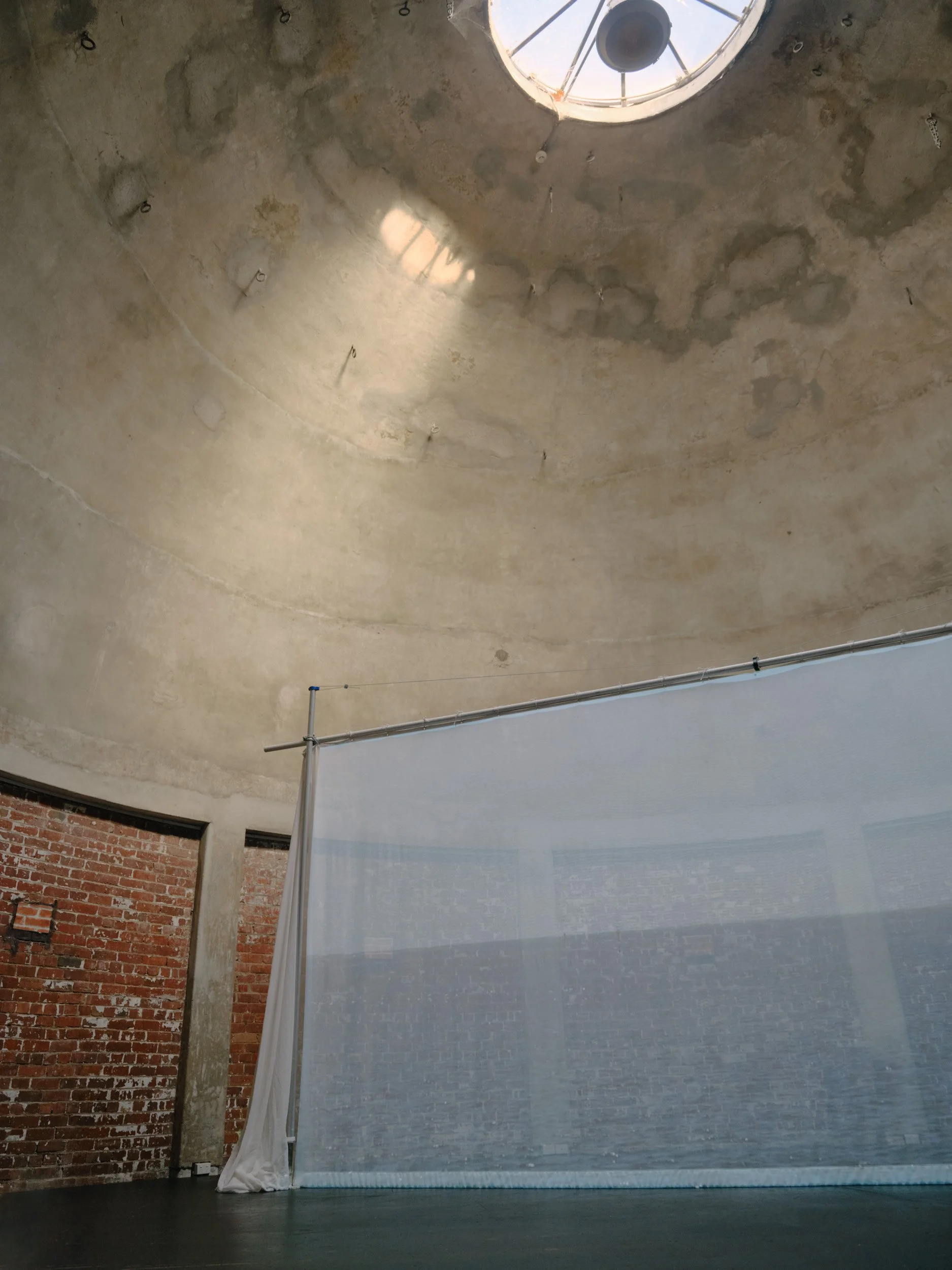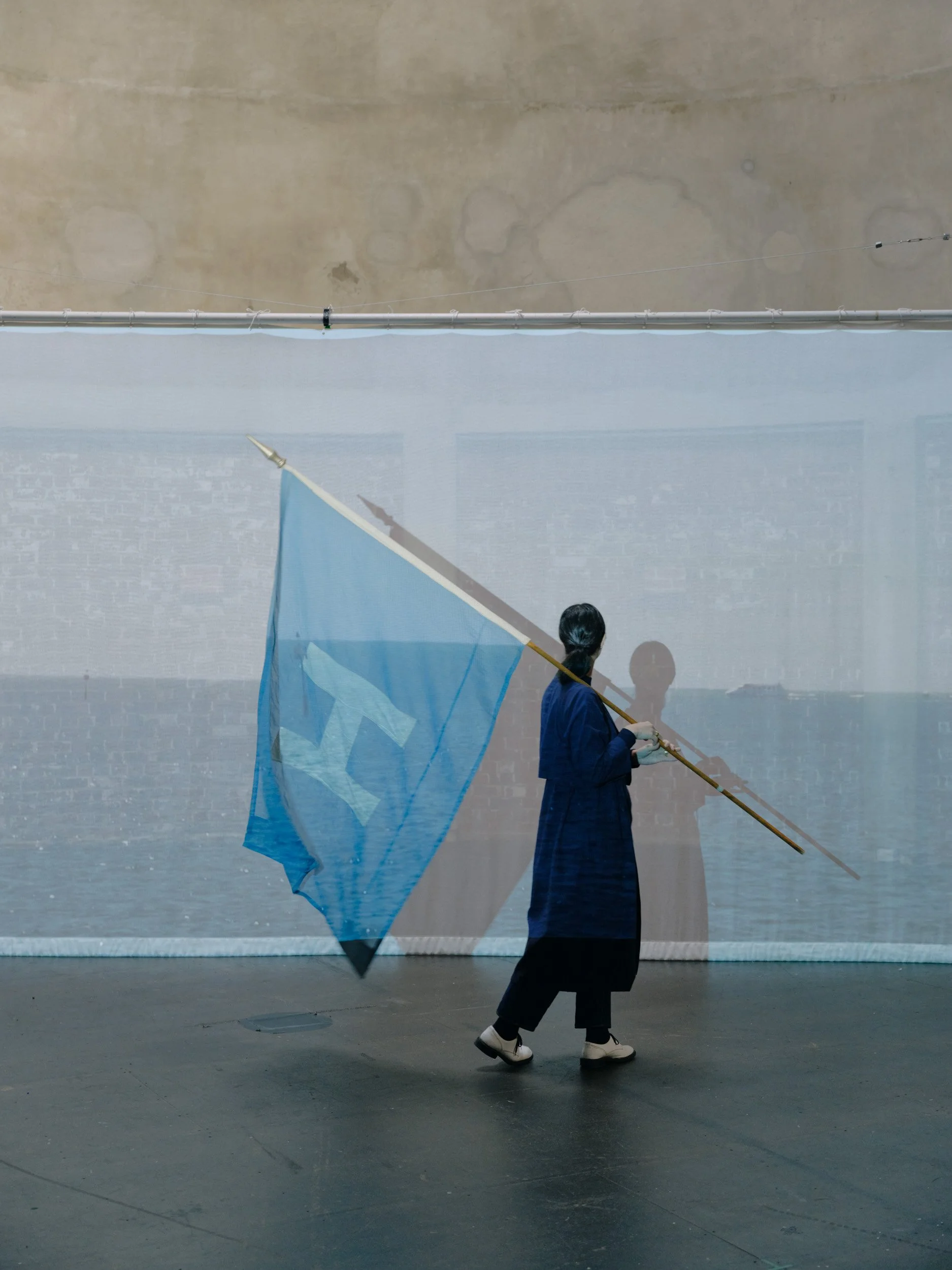The building wants to go back to the sea
Charity Edwards, Commissioned by Open House Melbourne, 2022
They think this is all solid footing, bricks, and dome but we started in the sea and we will go back. We were, from the beginning, afloat.
In 1857, we moored in Hobsons Bay – a bay within bays – and in abeyance of landed ways. An old prison ship, repainted as a church, and still a keep. The reverend regarded us at sea: loose, unfixed and unfocused.
They were concerned with what this might mean: away from the work of the sea, away from the work.
So the Seamen’s Mission took us towards the river and the wharf. We recall it as ‘werf’: a word from Old Dutch for land that was inhabited but not yet built upon. This was not their land but they built on it, to keep ourselves cared for and kept. In old boat sheds, shored up and sheltered.
And yet, here, we could still sense the ways away from land.
By 1900, we were so many. We were so many and we moved further and further into the city, and so many tempted us and took so much from our pockets, and the reverends worried for our care, both here and there: and especially there in the hereafter.
New homes were built for us, with their rooms bright and up in the air – and the Governor toasted every one of us: ‘The city of Melbourne is largely a gift from the sea … and Melbourne could not be what it is without the sailor’.
We continued to bring the sand and the cement to the shore; and the cementing of ourselves at its fore. We continued to be taken in and taken out, and taken for all we had.
And so out of the sea and its silt, its sailors and its filth, came a call for more care. A mission imitating other missions, Spanish and Franciscan; to build a mission in Melbourne in 1917. To hold us and help us. To care in between.
But this building also wants to go back to the sea: the bobbing about of its ins and outs, all those jutting prows and enveloping holds, upturned hulls and lonely crosses aloft. Hand-carved hearts in timbered bunks, a compass at the door and on the floor, and letters upon letters of lives and loves lost. Circling in on itself, drawing down, and keeping bodies moving deep in the diving bell of the dome.
We are already cracking and crumbling, undone by the work on the wharves, the settling of new homes around us, and rising tides pulling us ever down into the mud. We have been repatched and repointed, restumped and replastered but we are not solid, and we cannot stay fixed here for long.
We will fall apart and fall away, back into sand, silt and sea. And we will take care of ourselves out there
Orison
Justin Clemens, Commissioned by Open House Melbourne, 2022
so grey on grey the spheres are split and stand
and yet they move as ships upon the sea
of far horizons that a gaze excludes
within the shells within the shells within
so much is strange but nothing stranger than
the humans who set sail on ships that seek
the images of dream that can’t be found
beneath the starry skies and sun and moon
until they slip into the sands or sink
into the worlds beneath the whelming tides
where creatures shift along the whorls and wind
like domes of heaven spun like glassy spheres or
as a skein of waters infinite
no landmarks for the masts of masterless
adventures on the rip and beat of waves
beneath the starry skies and sun and moon
except the astral spheres themselves that catch
as constellations strewn across the dark
imaginary if real enough to mark
the planet’s surface with unrealised lines
the lines are lines of interrupted time
that mark the dreams that spin the wheel like suns
that blaze within the whirling worlds like spray
and drive us here and there through night and day
until the end of sailing drops its blade
and pieces drop as flotsam in the deeps
a moving ship upon a moving sea
goes back and forth across the frothing planes
among the islands and the continents
between the spurs and scales and promontories
we set up mast and sail on that swart ship
down to the breakers and the ocean’s cry
beneath the starry skies and sun and moon
where all the winds will lash the waves to foam
across the days and nights the spinning years
around the spinning world till time has spun
out revolutions of the planet’s space
as bitter ends that link the anchor’s neck
so much is strange but nothing stranger than
a moving ship upon a moving sea
beneath the starry skies and sun and moon
that back and forth within the hemispheres
of glass and sky in elemental strife
revolves immobile in its inner dome
calm like a mirror the fresh breeze will graze
the surface till it rises to a gale
and then a storm and then a hurricane
the blue turned white with fear then grey and stark
as all the staring eyes and broken helms
the jetsam of a tempest’s cosmic rage
the superhuman silences of wrecks
are everywhere but do not manifest
engulfed in the abyss and in the squall
the trace of foam that saw their going-down
O sidereal delirium that shows
a moving ship upon a moving sea
projected in a hemisphere of glass
inside a shipshape mission dome on dome
between the spurs and scales and promontories
so much is strange but nothing stranger than
the shifting shadows of these spinning spheres
a moving ship upon a moving sea
Circular Temporalities is a site specific art work that was commissioned for the exhibition Take hold of the clouds, curated by Dr Tara McDowell and Dr Fleur Watson for Open House Melbourne 2022
Tara McDowell, Catalogue Essay 2022
Inside the iconic Norla Dome at Mission to Seafarers, Ying-Lan Dann’s newly commissioned installation, Circular Temporalities (2022), brings together audio and video field recordings that consider the site’s relationship to global seafaring – and to the mariners stranded at sea during the pandemic. The primary component of the work is a silent, large-scale video projection of the sea crossing between Queenscliff and Sorrento shot from the ferry. The camera’s fixed position, and the horizon line it remains focused on, are destabilised by the movement of the boat itself, such that a seemingly static shot becomes subject to the motion of the sea. Projected onto a large scrim that bisects the Norla Dome just as the horizon bisects land and sea, the video insists on bringing the ocean into the dome, a windowless space sealed to the outside world, save for the ceiling’s oculus, which acts as a kind of sun dial. In this highly site-responsive practice, Dann moves beyond making the Norla Dome the subject of her work to allowing it to become the medium through which the work itself is made. Studying the dome, researching it, but also just as intensely playing and experimenting in it, has led Dann to create a sound and video installation that is layered, spatially, temporally and orally. The dome is an astonishing and curious structure – originally a gymnasium, hooks can still be seen pockmarking its smooth round interior. The residue of bodies – the absent bodies of mariners, to be specific – is palpable in the space. Dann emphasises the body in several moments in the work: the audio of a person running round the perimeter of the space, the slightly shaky view of the horizon image, seen from a camera standing in for our bodies, and of course, the visitor’s body, who engages the bar staff to ‘check-out’ silent disco headphones, which visitors wear in and around the dome, listening to a soundscape composed by Dann with sound artist Felicity Mangan and poet Justin Clemens.
News
Circular Temporalities has been selected to screen at ‘Intense Interiors’, Architecture and Film Symposium, Toronto Metropolitan University, Interior Design at the Creative School, Toronto, CA | May 6 & 7, 2023 I Architecture and Film Symposium
Credits
Circular Temporalities was commissioned on Wurundjeri land by Open House Melbourne 2022, for the exhibition ‘Take hold of the clouds’, curated by Tara McDowell and Fleur Watson.
Cinematography: Ivan Masic
Sound Production: Felicity Mangan
Installation and AV tech: Erik North
Poetry: Justin Clemens
Commissioned writing: Charity Edwards
Installation Photography: Tom Ross and Nick Bebbington
Thank-you Mission to Seafarers, Open House, RMIT, MADA, MUMA
Part of the sense of well-being we feel at the seashore undoubtedly has to do with the fact that the relaxed breathing pattern shows surprising correspondence with the rhythms of the breakers, which, while never regular, often produce an average cycle of 8 seconds.— R. Murray Schafer







